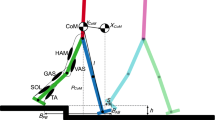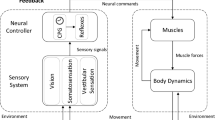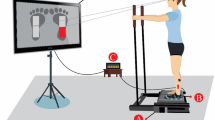Abstract.
The contribution of afferent feedback to the regulation of locomotion in humans is not well understood. Animal experiments have suggested that loading of the leg during the stance phase may enhance the magnitude of extensor burst activity and delay the onset of swing phase. The aim of the present study was to determine whether transient loading of the leg at the end of stance would enhance extensor-muscle activity and delay the onset of swing in walking humans. To test this hypothesis, we applied loads to the hips of subjects so that the load was applied along the long axis of the leg at the end of stance (down-back unsupported, DBU). This resulted in an unexpectedly complex reaction characterised by rapid co-contraction of antagonist pairs of muscles around the ankle and knee and a prolongation of the stance phase. We speculated that the complexity of the reaction was, in part, due to a disturbance in equilibrium. To address this possibility, two additional perturbation paradigms were tested: (1) subjects held a rail during the loading paradigm (down-back supported, DBS), or (2) subjects received only a posteriorly directed perturbation of the hips, which added no additional load to the leg (backward unsupported, BU). As predicted, the DBS perturbation resulted in an enhancement of the ongoing soleus-muscle activity, and the unexpected tibialis anterior burst that was observed during the DBU paradigm was absent. Allowing the subjects to hold a rail substantially reduced the change in the timing of the step cycle observed in the DBU paradigm. The BU perturbation prolonged the stance phase duration and, as expected, resulted in a burst of activity in tibialis activity. This was usually accompanied by a reduction in the ongoing soleus activity. Two important conclusions are drawn from the present study. First, loading of the leg at the end of stance phase enhances the ongoing extensor-muscle activity. We suggest that afferent feedback responding to the increase load supported by the leg leads to rapid enhancement of the active extensor muscles to compensate for the increased load and prevent collapse of the leg. Interestingly, the duration of the stance phase was only marginally increased when loading was applied without a postural disturbance (DBS). Second, posterior perturbation of the centre of mass at the end of stance phase evokes an "automatic postural response" in tibialis anterior. Of particular interest, this evoked postural response can occur simultaneously with an enhanced activation of soleus. This indicates that the DBU perturbation employed in this study elicited two responses, one to prevent the collapse of the leg and the other to stabilise the centre of mass.
Similar content being viewed by others
Author information
Authors and Affiliations
Additional information
Electronic Publication
Rights and permissions
About this article
Cite this article
Misiaszek, J., Stephens, M., Yang, J. et al. Early corrective reactions of the leg to perturbations at the torso during walking in humans. Exp Brain Res 131, 511–523 (2000). https://doi.org/10.1007/s002219900315
Received:
Accepted:
Published:
Issue Date:
DOI: https://doi.org/10.1007/s002219900315




